
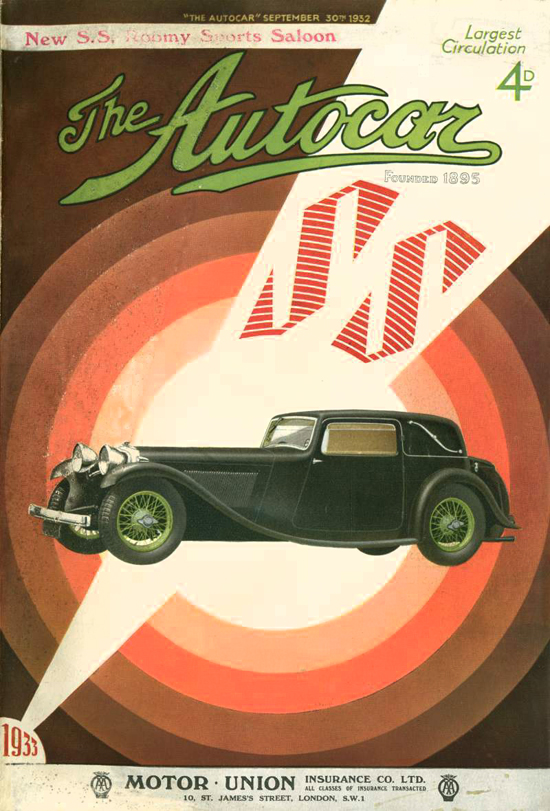
80 Years of Grace and Beauty
By Geoff Wheatley
2011 was the 80 th Anniversary of the SS Jaguar Company although the term Jaguar was not used until 1936. The SS1 was simply known as the SS Coupe. This is a brief history of the now famous Jaguar Sports car.
In 1931 a small manufacturing company in Blackpool, England that made sidecars for motor cycles, a means of transport popular at that time, decided to design a car. In reality the owner of the Swallow Sidecar Company, William Lyons wanted a car that would impress his customers and yet cost little more than any popular family vehicle.
The end result was the “SS1” that was offered to the public in the spring of 1932.
A sleek looking vehicle featuring the long low hood associated with the Monte Carlo style of continental car. Under the imposing hood was a two liter side valve engine supplied by the Standard Motor Company. With a tail wind the SS1 Might hit seventy miles per hour; however, by 1933 a two point five power unit was featured that gave the car an extra thrilling five miles an hour for top speed.
Despite this unimpressive performance the image was one of grace and desire indicated by the chosen name of “Jaguar”. (Not used until 1936).It is interesting to note that this was not the first name chosen by the company. As the fastest animal on four legs is the Cheetah this was seriously considered but as the term could easily be associated with a dishonest situation the name Jaguar won the day and became both the Company name and of course its symbol, now recognized throughout the world. It is recorded that Lyons took his daughter to the local zoo and while there she noticed that the Jaguar was listed in the top three speed animals of the world. Aware of her Fathers desire to find a name for his new car she suggested Jaguar because it was fast sleek and beautiful. It seems she certainly had good taste!
As indicated in reality performance was secondary to the sheer grace and charm of the Jaguar assisted by its showroom price of just over three hundred pounds. Similar looking vehicles that might have gone a little faster cost at least 50% more.
Image Submitted by Rick Feibusch 2012
Jaguar SS100 1936: Image Submitted by Rick Feibusch 2012
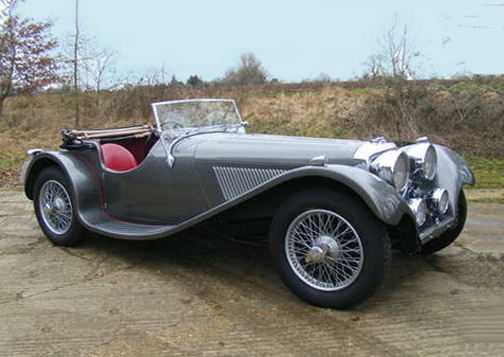
Remembering that these were the years of the depression when money was tight even in the market for these quality cars, Jaguar had the edge on any competitor. Years later Lyons was described by a leading motor publication as the man who could build cars that looked expensive which in gave them an extra showroom appeal. This was true right through the post war period of Jaguar production. A combination of beautiful styling coupled with a performance equal to almost any other vehicle on the road at an attractive price. Even in the heyday of Jaguar between 1950 and 1970 Lyons kept the price range within the pocket of the average motorist yet these vehicles set a standard in style and design that many other manufacturers could never follow. As already mentioned the early SS range was never a fast car unless the purchaser requested that a special power unit be installed which could be accommodated at the Jaguar factory for a few extra pounds! One such modification was the use of the Standard OHV two and a half liter high compression engine that could push the performance up another ten mph. In 1936 at the Brooklands Race track the SS 90 with this power unit recorded a true 90 mph followed in 1938 with the famous SS 100 that justified its index by recording 102 mph on a measured mile. To add to the new attraction of performance the SS 100 sold for only three hundred and ninety five pounds, again about half the cost of any other car in that class.
With the commencement of the Second World War in 1939 private production ceased at the Birmingham Jaguar factory, like other companies, Jaguar turned to war requirements. Engine design was one of the fields that they developed in company with Rolls Royce who used several facilities such as Jaguar to test and explore new design factors. By the end of the war, with Britain was in debt and broke, Jaguar like other vehicle manufacturers was caught up in the “Export or Die” policy of the new British Government. If motor manufacturers did not have a high record of Export to earn dollars they were denied steel for production.
A few reverted to alloy for their car production but this was never successful as the production requirements was three times as expensive as press steel. Between 1946 and 1948 Jaguar continued to produce vehicles that were based on pre war design utilizing their prewar engine supplier Standard Motors. (Standard were the principle suppliers of engines to around 50% of the British Motor Companies until the 1950’s. Their success with the bankrupt Triumph Motor Company in the post war years is a good indication of professional management however, that is another story for another time.)
Jaguar XK120 1950: Image Submitted by Rick Feibusch 2012
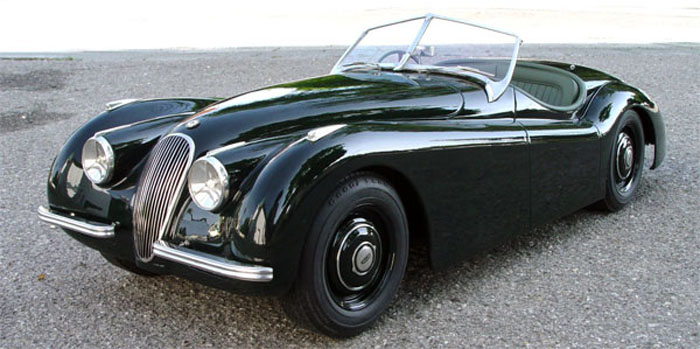
Unbeknown to any competitors a completely new design was in the pipeline for Britain’s export market powered by a completely new engine design prompted by Jaguar’s war time experience. The term SS had been dropped by the company for obvious post war reasons to be replaced by a simple number that represented the performance of the car.
At the 1948 Earls Court Motor show the new Jaguar 120 sports car was introduced.
To say that it was an instant success would be the under statement of the year! In a matter of ten days orders had been taken for the six months of production. An American Dealer wanted to purchase the first years production but settled for a thousand cars.
Jaguar had now become a top export company in the UK second only to Morris and Austin whose range of vehicles was designed for a more general market!
The Jaguar 140 followed the 120 and won the Le Mans in 1951 and 1953, while the Jaguar 150 the African ten day rally three years later
Various other Jaguar products maintained a steady market share in the following years but the image of a fast sleek vehicle began to fade especially as the price increased and the performance remained fairly static. The Motor Press started to look on Jaguar as a falling star as its range of vehicles started to show their age. A serious fire at the Jaguar factory did not help the situation. Like other UK manufacturers Jaguar maintained a sports competition division and raced special Jaguar cars such as the D Type. Based on this design Jaguar created a new sports car introduced in 1961, the Jaguar E Type a 150 mile an hour vehicle with a 3.8 liter six cylinder engine. Like its cousin the D Type this looked like it belonged on the race tracks of the world, and of course it did! To my mind one of the most attractive vehicles ever produced. The competition had nothing to compete with this vehicle especially at a price of just over two thousand UK pounds... Not content with the success of the E Type Jaguar introduced the V12 E Type Roadster with a five and a quarter liter unit under the hood. Since that time Jaguar has had a series of new owners, not always for the better. British Leyland almost destroyed the marquee through poor quality control in the 1970’s How ever Ford came along and saved the both the name and the car. Will we ever see another world breaking Jaguar offered to the public? Who knows, but with a history and pedigree unequaled by any other popular manufacturer I sincerely hope so even if it has an Indian master!
© 2012 Geoff Wheatley
|
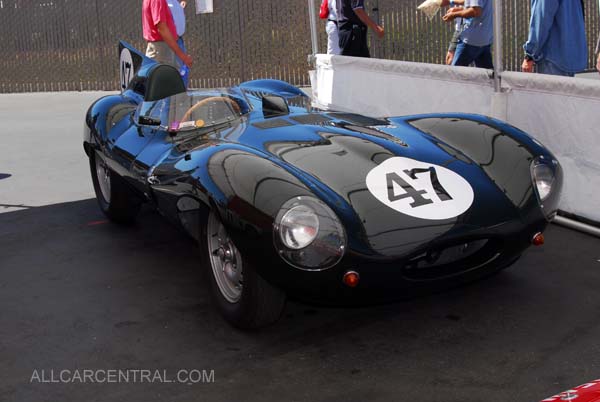
Jaguar D Type sn-XKD 575 1955
34th Rolex Monterey Historic Automobile Races,Mazda Raceway
Laguna Seca, 2007
|
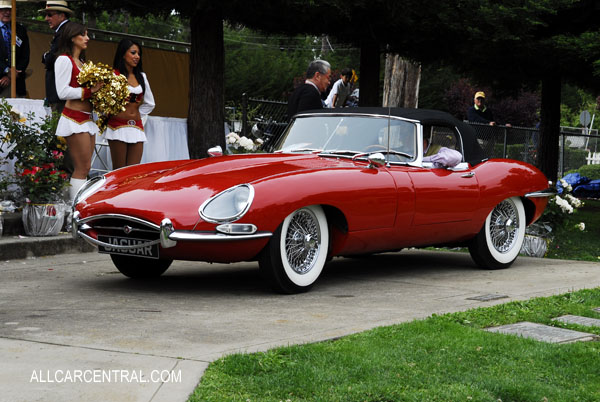
Jaguar E Type Series-1 1961
Strother MacMinn Award
Hillsborough Concours d'Elegance 2009
Hillsborough, California
|
|
BACK TO TOP
Allcarcentral.com is in no way associated with any automotive manufacture, race track, race event.
All automotive brand names, model names and event names are the property of the respective manufacture and event owners.
|




